CALTEX TAKES PRECAUTIONS AFTER BLAZE
The Caltex Refinery in Milnerton is to be shut for at least two weeks
following a fire in one of its pumps on Friday and major customers' fuel
supplies are to be rationed as a "precautionary measure". The
refinery's manager said on Sunday that most of the refinery had been shut
down so the damage could be assessed. "We will be down for at least
two weeks while we look at the damage," said the manager. "Until
we do the initial assessment we don't have a feel of the damage and the
cost. "As a precaution, we are going to do rations of all our biggest
customers to make sure we don't have a supply problem. This is the responsible
thing to do." The refinery's public affairs manager said although
product supply was not expected to be affected, as a precaution the company
would develop contingency plans until the extent of the repairs needed
was known.
The fire broke out about 6.40pm on Friday and was extinguished by 8pm
by the refinery's emergency service teams, assisted by the Milnerton fire
station. The refinery manager said an investigation into the cause had
been launched. "When anything goes wrong I launch an investigation
to find out what the problem was. "We treat it like a forensic investigation.
We are doing everything we can to prevent incidents." Refinery staff
had met officials of the department of environmental affairs and tourism,
the department of environment and development planning and the City of
Cape Town's air pollution control to provide them with an understanding
of the incident. The police and department of water affairs and forestry
also visited the site. "Today contractors will come in to do the
assessment," said the refinery manager. "We also do turn-arounds
every year to tune things up. This is one of the safest refineries in
South Africa and we make sure there are no injuries."
Residential areas flanking it have been concerned about the refinery's
safety following a number of incidents. The fire was the fourth incident
this year. Last year, during a routine annual shut-down of the refinery
for maintenance, oil rained on neighbouring houses and cars. The Democratic
Alliance has called on the department of minerals and energy to ensure
the refinery's management undertakes a thorough investigation of the fire.
The DA spokesperson on minerals and energy, said the fire broke out hours
after members of the portfolio committee on minerals and energy and select
committee on foreign affairs visited the refinery. "It appears from
information gathered during our visit that the steps taken by Caltex to
make the refinery safer are inadequate," said the spokesperson.
FF's INJURED WHEN APPROACHING CAR FIRES
There has been another strut incident at a car fire. A Sacramento, CA
Metro firefighter was very lucky in January after a super-heated strut
under the hood of car on fire exploded, sending the 1" cylinder through
the vehicle's body and right through his leg before "landing"
more than 50' away. "I moved to the passenger side of the vehicle
and started to extinguish the fire through the front grill when all of
a sudden, we heard a large explosion," said the firefighter. The
strut was so hot it actually cauterized the firefighter's wound, just
missing the victim's femur before exited through the back of his leg.
The firefighter is recovering and expects to be back at work next week.
Similar situations have occurred to other FD's as well...one specifically
in CT several months ago that is covered in the current issue of Firehouse
Magazine, "Close Calls" Column, Pg 26. As we wrote, it's JUST
a car fire-one where our risk should be minimal when we cautiously approach
in/from a safe area w/full PPE and a charged & flowing line to cool
& reduce the temps of the vehicle/strut areas.
A Windspr Locks Firefighter was hospitalized after suffering a leg injury
while fighting a car fire on Nov 21st. While attempting to open the hood
latch one of the hood struts exploded sending the strut completely through
the firefighter's upper thigh. The firefighter is home recovering from
his injury.
GAS EXPLOSION KILLS FIREFIGHTER, INJURES THREE OTHERS, IN NORTHWEST ITALY
A firefighter was killed and at least three others were injured in an
explosion triggered by a gas leak Wednesday in this northwestern port
city, fire officials said.
A leak in a tanker truck first ignited a fire, they said. When firefighters
arrived to battle the blaze, they were hit by the explosion, they said.
Firefighters said details were still unclear. The Italian news agency
ANSA said that as many as 10 people were wounded, but that report could
not immediately be confirmed.
View full story here
WORKER DIES ON NORTH SEA PLATFORM
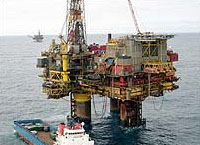
A man has died on a North Sea oil platform off the coast of Shetland.
Electrician Graeme Burns, 47, died while carrying out maintenance work
with a colleague on Brent Bravo on New Year's Day. The pair were in a
leg when they smelled gas at 0230 GMT. The victim, from Largs, who worked
for the John Wood Group, collapsed and died. An inquiry has begun into
his death on the platform, which is 116 miles north-east of Lerwick. Its
owner, Shell, said it was investigating the death with Grampian Police
and the Health and Safety Executive.
Gas detectors
The company said the smell the men detected may have been a naturally
occurring gas and it did not believe there had been a leak in the platform
leg. A spokesman said: "The victim and a colleague were working in
the utility shaft when they smelled a minor amount of gas. "One of
their portable gas detectors registered the presence of gas but none of
the 11 gas detectors in the shaft registered gas. "They donned breathing
equipment and began to evacuate the shaft. For some reason yet to be determined,
the victim stopped climbing the stairs of the shaft. "He was later
found unconscious. Medical assistance was applied but unfortunately he
was pronounced dead. Our sympathy goes out to his family and colleagues."
Previous deaths
In September 2003, 2 oil workers died after a sudden escape of gas when
they were working inside the same utility shaft. A Grampian Police spokesman
said: "We can confirm that we have officers at Brent Bravo making
inquiries into the death of a crew member on that installation. "Obviously
it is too early to speculate on the circumstances surrounding the death."
View full story here
NEW ZEALAND, RICHMOND, JANUARY 28 2005. FIRE IN OIL TANK CAUSES 'SPECTACULAR FLAMES'
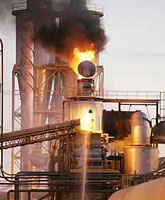
A fire in an oil tank containing thousands of litres of oil broke out
at Nelson Pine Industries' MDF plant in Richmond this morning. Richmond
Volunteer Fire Brigade chief fire officer said the fire started around
3.30am sending thick black smoke billowing over Tasman Bay.
Fire fighters initially feared the fire was bigger than it was, as burning
oil from the tank was venting through a furnace next to the tank, and
causing "spectacular flames" to leap outof the furnace. There
was also concern at the potential from oil from the leaking tank to spill
into the Tasman Estuary. Eight fire appliances and about 40 firefighters,
with engines from Richmond, Stoke, Wakefield and Nelson battled the blaze.
The fire was under control by 7am this morning, but controlling the fire
was initially dangerous and difficult due to the enclosed nature of the
fire and because of the threat of explosions or flash backs, the chief
fire officer said.
Oil leaking from the fire was also burning, causing running fires towards
drains and buildings, which also made accessing the fire tricky. Firefighters
were only able to reach the fire once they had significantly cooled the
tank, and could remove the hatches off the top of the tank, the chief
fire officer said. "We had to prise the hatches off very slowly,
as we didn't want to get a flash back." "When that happened
(getting the hatches off) we were able to cool it quicker and the fire
went out." The chief fire officer said the oil leaking from the tank
was contained in a holding reservoir at the back of the MDF plant.
There was no threat of oil leaking into the estuary, as the sluice gates
were shut and the level of water in the reservoir was low, the chief fire
officer said.
Workers at the plant were evacuated during the fire, and the factory
was partially running againby nine o'clock this morning, the chief fire
officer said. The cause of the fire was not known this morning. Damage
from the fire was contained to the tank and the area around it. Nelson
Pine Industries managing director was unavailable to comment this morning.
The MDF plant employs 275 people and produces and exports medium density
fibreboard and laminated veneer lumber.
WORKER HOSPITALISED AFTER GAS EXPLOSION AT TUAS COMPANY
A worker suffered serious head injuries when an explosion occurred at
a company producing various natural gases in Tuas. The incident took place
on Wednesday at Linde Gas Singapore Private Limited, and the technician,
a Chinese national in his twenties, was sent to the National University
Hospital where he was warded.
Singapore Civil Defence Force (SCDF) officers received a call around
10.40am about the incident. "I heard a very loud bang. I saw some
smoke and then there was smell of gas. I was not sure if it was poisonous.
I quickly ran back to my factory," said eyewitness. Fortunately,
there was no fire as a result of the explosion caused by two gas cylinders,
each weighing 50 kilogrammes.
When civil defence officers arrived at the scene, they found about 20
other unaffected cylinders in the gas filling room. "What SCDF did
was to make sure that there was no further threat of fire or any explosion
by shutting down the plant first. After that, we moved in into the gas
filling room to remove all the unaffected cylinders," said the Commanding
Officer, Tuas Fire Station. This is the first time an explosion has happened
at Linde Gas, a German company which has been operating out of Singapore
for nearly five years.
Both the company's management and the SCDF are working closely to find
out how the explosion happened. The company deals in speciality gases
for a range of industries, including chemical, medical and electronics
manufacturing. It employs 28 staff, most of them Singaporeans.
View full story here
SOUTH AFRICA'S SASOL INVESTIGATES GAS LEAK,17 HURTSouth
South African synthetic fuels maker Sasol said on Thursday it was investigating
a fire and hyrdofluoric gas leak at its Natref oil refinery near Johannesburg
in which 17 people were injured. The company also said it had appointed
US safety consultancy Du Pont to review procedures and management after
a series of accidents at its plants since last June in which at least
13 people have died. "Sasol remains highly concerned about the trend
in accidents ... every effort is being made to reverse this trend and
is the top priority for the group," a company spokesman said in a
statement.
After the latest accident on Wednesday, Sasol is removing product inventory
from the Natref refinery at Sasolburg, south of Johannesburg, which it
jointly owns with French oil giant Total, it said. This might result in
minor releases of product under controlled conditions but is not a matter
of concern, it said. "It is suspected that a seal on a pump became
defective, leading to the gas leak, which ignited," the company spokesman
said. "Of the 17 employees and contractors taken to a local hospital
... 16 have been discharged, and only one remains in hospital for further
observation and shows no signs of any complications," he added.
In line with normal procedure, South Africa's Labour Department is also
investigating the accident. Refinery production was unaffected because
the plant was undergoing routine maintenance, and a preliminary assessment
showed that the incident did not affect the environment, the company said.
View full story here
DIESEL FUEL SPILLS INTO CLERMONT COUNTY CREEK
Emergency crews in Clermont County and a HazMat team are trying to clean
up an accident that ended with a large diesel fuel spill. Williamsburg
fire officials say a car and a semi carrying a trackhoe collided head-on
on State Route 133 just south of Williamsburg Tuesday night. The semi
ran off the road and into a creek, then started leaking around 100 gallons
of diesel fuel into the water.
The truck's driver appeared to have minor injuries, but the driver of the
car was trapped for almost 45-minutes. Hazmat teams were on the scene late
Tuesday night trying to contain the spill. They were digging a trench to
siphon the fuel out of the creek. Officials from the Environmental Protection
Agency (EPA) and the Ohio Department of Natural Resources (ODNR) are expected
to inspect the crash site Wednesday.
A TRUCK CARRYING 30,000 LITRES OF AVIATION FUEL SPARKED A SPECTACULAR FIRE IN WAIKATO TODAY.
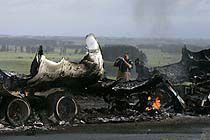
The smouldering truck was a molten mess early this morning, while a massive
plume of smoke floated high in the air above the scene near Ngatea on
the Hauraki Plains.
The blaze started about 3.15am on SH27, and the truck was destroyed.
The driver escaped uninjured. Nine fire trucks from Ngatea, Paeroa, Tahuna,
Auckland and Hamilton raced to the scene. The road was still closed this
morning while more than 30 firefighters cleaned up the mess and took safety
precautions. The road was expectedto reopen by lunchtime.
The Fire Safety Officer said it was decided to let the aviation fuel
burn off rather than risk environmental damage by putting it out. The
fully laden tanker was bound for Taupo Airport, the Fire Safety Officer
said. Investigations into how the fire started were under way, but Hamilton's
deputy chief fire officer said initial indications were that a tyre blow-out
or a malfunction in the wheel assembly caused sparks that ignited a small
amount of the fuel.
The chief fire officer said it was lucky the truck was full with fuel
because an air chamber could have caused a large explosion. He praised
the truck driver for pulling into a lay-by when he realised the danger
unfolding. "There are a large number of trucks on the highways in
the Waikato area that are carrying bulk hazardous substances and fuel,
and the potential for incidents like this are quite high," the chief
fire officer said.
POTENTIAL OF CATASTROPHIC FIRE FROM TERRORIST ATTACK
WORRIES LNG OPPONENTS
The Algerian inferno a year ago undermined industry arguments that the
modern era of LNG transport is inherently safe.
It also became rallying point for groups fighting proposed new LNG terminals
in their towns. Companies are beginning to gear up for LNG imports. As
many as a dozen new terminals are expected over the next decade. To many
energy experts, fear of a devastating LNG fire from an accident or terrorist
attack is the toughest obstacle facing the industry.
A recent government report, the most comprehensive examination of LNG
tanker risks to date, concluded that terrorists have the capability to
tear a huge hole into a tanker. That would unleash a spill and intense
fire that would cause major injuries and burn buildings as far as one-third
of a mile away. People a mile away could suffer second degree burns, the
report said.
LNG imports are widely acknowledged to be crucial in meeting future natural
gas needs. Yet public concern about safety has led more than a half-dozen
communities to reject an LNG import terminal or rally against a proposed
facility. Critics want double-hulled tankers carrying more than 30 million
gallons of LNG barred from traversing waterways in populated areas or
within a mile of homes, schools and office buildings. Industry advocates
say the safety risks are exaggerated, citing a 40-year history of more
than 35,000 shipments of LNG worldwide without a significant release of
the fuel or a fire. They also argue that the Algerian accident, involving
a liquid gas leak and explosion set off by a spark from a boiler, could
not happen at U.S. facilities because of different equipment and design.
The recent federal study by Sandia National Laboratory found potentially
harrowing consequences from spills. The report also said the chance of
an intentional spill could be reduced greatly with "a halo of security"
for arriving tankers. "We can significantly reduce the likelihood
of a terrorist attack occurring with security planning and mitigation,"
says a deputy assistant secretary for fossil fuels at the Energy Department,
which commissioned the Sandia study.
The executive director of the Center for Liquefied Natural Gas, an industry
trade group, does not dispute the Sandia report's assessment of a "worst
case" LNG accident. But, he says, the "remarkable safety record"
and close government scrutiny of LNG shipments make such an accident a
"low probability." The Sandia study, in fact, concludes the
risks of an accidental release of LNG from a tanker are small. But it
is post-Sept. 11 fears about terrorism that bring a new dimension to the
debate over LNG transport. For nearly half a century, the emphasis has
been on preventing human error, not intentional acts.
Since the terrorist attacks, the Coast Guard has imposed tighter security
on LNG tankers. Measures include four days notice of a tanker's arrival,
information on its last ports of call and crew, and special sweeps and
vessel boardings. Rear Adm. the Coast Guard's assistant commandant for
marine safety and security, said the Sandia findings will help "in
further refining our risk reduction efforts." The study's classified
version includes specific attack scenarios and their likely impact.
As a frosty liquid, kept at minus-260 degrees Fahrenheit, LNG cannot
explode or catch fire. Various studies agree that if a tanker is breached
by a bomb or missile, the liquid flowing from its icy storage instantaneously
would become a gas and ignite. The result: an extremely hot fire, as wide
as three football fields. The Sandia study concluded that a terrorist
attack could blast a large enough hole -- and possibly several holes --
that would cause cascading damage. The cold liquid and intense heat of
the fire would weaken adjacent tanks, causing them to fail and adding
to the size of the spill and the blaze atop the water. "The fire
from such a spill would be very large ... perhaps up to a half-mile in
diameter, or larger if more of the containment system failed," says
a professor of chemical engineering at the University of Arkansas. "We
have no experience with fires this large, but we do know they could not
be extinguished. They would have to burn themselves out," says the
professor, who over three decades has studied the likely impact of LNG
fires.
The industry's good safety record has actually made it harder to determine
how much damage a large spill might cause. The only tests have been on
spills of 10,000 gallons of LNG, not the 3 million gallons or more that
scientists believe would be released if a tanker were breached by a bomb
or missile. Computer models about a major LNG vessel spill have produced
widely different results. One study assumed only a 3-foot hole and that
waves would limit the spread of the fire. A second study assumed a breach
of more than 30 feet across, resulting in a rapid spill and much bigger
fire. These models are uncertain because they rely on assumptions "about
which fair-minded analysts may legitimately disagree," the Congressional
Research Service said.
The Sandia study was ordered with the hope of resolving some of that
disagreement. It found "that the worst that can happen or near worst
... is really more than the industry has admitted so far," says a
semi-retired professor at the Massachusetts Institute of Technology. Since
1970, the professor has argued the government and industry were understating
the potential dangers of a major fire.. In an interview, he said the Sandia
study documented "that the worst that can happen is very bad."
He scoffed at the suggestion that the impact of an LNG spill and fire
could be mitigated. "The fire is over in five minutes," he said.
"You can't sound fire alarms and tell people to shuttle away from
the harmful effects."
A Repuplician Politician, who has pressed the Bush administraion for
tighter restrictions on siting LNG terminals, said the Sandia report has
"destroyed any argument that LNG facilities should be based in urban
areas." A 1979 law says LNG regulators should "encourage"
remote siting of import terminals. The politician however, says regulators
have ignored Congress' intent and continued to consider sites in densely
populated areas, especially in the Northeast where LNG facilities are
being proposed in Providence, R.I., and in Fall River, Mass., and where
tankers would travel through the heart of the community.
A senior official at the Federal Energy Regulatory Commission who is
involved in LNG terminal siting, says he has no illusion about the prospects
of an LNG-fed inferno spreading over water. "It's a fire that can't
happen," he said from his office near the Capitol. He meant that
it cannot be allowed to happen. But he also insists that federal security
requirements are sufficient to prevent terrorists from causing a spill.
"If I had to worry about my safety, or my family's safety, I'm a
lot more worried working this close to the Capitol building than I would
be living close to an LNG facility," he says.
Energy regulators have a dozen LNG terminal site proposals under consideration.
They have approved expanding the four existing terminals and have given
a green light to three new ones on the Gulf Coast. Regulators must ensure
the risk "is as close to zero as possible" while recognizing
the need for reliable and affordable supplies of LNG, said the commission's
chairman in an interview. But he added that he and fellow commissioners
"also recognize there is an economic need here if you want to have
reliable and affordable supplies" of natural gas. A native of Port
Arthur, Texas, the commission's chairman says three LNG import sites "are
going in my hometown potentially" and that has given him a strong
incentive to make sure the public is not in danger. But in Fall River,
Mass., the Mayor is not convinced that the government is committed to
protecting the 5,000 people who live or work within a mile of a proposed
LNG terminal in his town.
FERC officials acknowledged in a report that a tanker would have to maneuver
up the Taunton River, which cuts through the heart of Fall River, and
under four bridges, including one carrying an interstate highway. But
the report also said risks from a possible terrorist attack on a tanker
"can be managed." The commission has yet to rule on the project.
"It's downright foolish," the Major said in a telephone interview.
They want the town to bear "a risk no American citizen should be
asked to bear when there are alternatives."
On the Net:
Federal Energy Regulatory Commission:
Center for LNG
Energy Department
CHEMICAL SPILL SICKENS DOZENS AT JACKSON COUNTY PLANT
Hazmat crews spent hours at an auto parts plant in Crothersville Friday,
trying to determine what caused a chemical spill there. It happened around
7:30 Friday morning at Aisin Drivetrain, Inc. WAVE 3's Frances Kuo reports.
Fire officials are still trying to determine a cause, but they believe
hydrochloric acid got into a mixture that an employee was working with.
"Our environmental technician was conducting a normal daily activity
where he was cleaning out the system, and during that cleaning process,
he noted the chemical reaction," said Vice President of Operations
at Aisin.
Crews from the Crothersville Fire Department, Jackson County EMS and
hazmat teams didn't get the call until an hour-and-a-half later, when
people started showing symptoms. "The physical reaction to this is
kind of a delayed type of thing, so it was more or less around 9 o'clock
when people started getting sick," said Asst. Chief of the Crothersville
Fire Department. "A lot of people were vomiting and having a lot
of problems with nausea." More than 100 people were evacuated from
that part of the building, and 28 were taken to area hospitals and decontaminated.
Authorities say they acted quickly as soon as they arrived at the scene,
which prevented the situation from becoming worse. "Not knowing for
sure what type of chemical it was, obviously you're better safe than sorry,
you get everybody out," the Asst. Chief Fire Dept said. He also said
overhead doors in the affected area helped clear some of the vapor. As
of Friday evening, two workers are still at Seymour Hospital for observation.
The factory was fully operational Friday afternoon.
View full story here
A MAN LOOKS AT DEAD CATTLE IN A RIVER AFTER OIL SPILL IN VERACRUZ

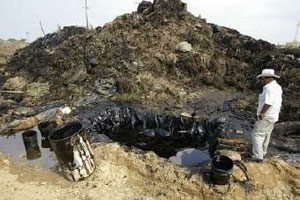
A man, his face covered against the fumes, looks at dead cattle in and around a river in Aguadulce, Veracruz, after a Pemex pipeline ruptured and semi-refined gasoline, known as naphtha, spilled into a local river January 27, 2005. The director of state oil monopoly blamed the spills on years of lack of investment in maintenance of ducts and pipelines.
View full story here
MAN REMAINS IN CRITICAL CONDITION AFTER REFINERY CHEMICAL SPILL
A man injured at the Alcan Gove refinery at Nhulunbuy in the Northern
Territory remains in a critical condition a week after a spill left chemical
burns on most of his body. The victim was flown to Royal Adelaide Hospital
in South Australia for treatment to burns sustained when the sodium hydroxide
leaked from a container he was depressurising.
The Alcan Gove bauxite mine and alumina refinery is located at Nhulunbuy
on the Gove Peninsula in the east Arnhem Land region of Australia's Northern
Territory. The Northern Territory Department of Industry isexpecting the
report from an investigation into the incident later today.
View full story here
GAS STATION FIRE
Fire crews say it took nearly half an hour to get the blaze under control.
Jacksonville fire investigators are looking into what started a fire
at a local gas station Monday. It happened at the Citgo station at 3260
Beach Blvd. That gas staion is now closed. Fire crews say it took nearly
half an hour to get the blaze under control. There were no injuries, but
the convenience store at the gas station had a lot of damage. Workers
at the station say they were having electrical problems yesterday, but
that has not yet been ruled the official cause of the fire.
View full story here
EXPLOSION FORCES EVACUATIONS IN S.WHITEHALL
An underground gasoline pipeline ruptured and exploded Tuesday morning
in South Whitehall Township and forced the evacuation of homes and businesses
in the area, officials said.
There were no immediate reports of injuries or property damage in the
explosion, which happened around 6:30 a.m. on Huckleberry Road near Wehr
Mill Road in South Whitehall Township, a supervisor for the Lehigh County
Emergency Management Agency said.
Emergency workers shut off a valve leading to the pipeline, and firefighters
are waiting for the fire to burn itself out. The FBI and the federal Bureau
of Alcohol, Tobacco and Firearms have responded to the explosion. Utilities
in the surrounding area were shut off as a precaution, according to police
scanner reports. South Whitehall police said the fire is stemming from
an 8 inch Exxon/Mobil gasoline pipeline.
Police responded to reports of an explosion shortly after 6:30 a.m.,
said the Police Sgt. Police evacuated nearby residents from Walbert Ave.
to the Turnpike and Old Century Road to Bradford Drive. A statement from
Mobile Pipe Line Co. said the company experienced a leak of petroleum
products on its pipeline system in the area which apparently ignited and
caused the fire.
People were first evacuated to the South Whitehall Township municipal
building, but smoke forced them to the Parkland Area School District administration
buildings. The Township Manager said the EPA and DEP were both on the
scene and they don't believe there's an airborne hazard from the large
plume of smoke that resulted from the fire.
The Federal Aviation Administration has restricted flights in the area
from entering airspace within a mile of the explosion. State officials
say people with respiratory ailments living in the area should stay inside.
Traffic in the area had been snarled, but Parkland Area School District
officials said it did not affect students significantly in terms of getting
to the high school in the morning commute. All utilities are operational
at the high school, which is about a mile away from the explosion site.
A resident who lives on Lapp Road in the township, less than a mile to
the south of the explosion site. She said she was up around 6:30 a.m.
getting her sons ready for school but didn't hear any explosion. "First
I noticed is going outside and seeing the black cloud, it's been there
all morning," she said. "But there's no odor that we noticed,
the wind is going in the other direction." The resident said utilities
at her home had not been affected.
According to its Web site, ExxonMobil Pipeline Co. and its affiliates
are engaged in transporting approximately 3.5 million barrels per day
of crude oil, refined petroleum products, liquefied petroleum gases, natural
gas liquids, and chemical feedstocks through 11,000 miles of pipeline
in 21 states, the Gulf of Mexico, and Canada.
USA, WASHINGTON, FEBRUARY 1 2005. INPUT REQUESTED ON INTERMODAL TRANSPORT
TANK REQUIREMENTS
DOT, RSPA, Office of Hazardous Materials Technology, and the American
Society of Mechanical Engineers, International (ASME) have established
a committee to consider technical requirements for transport tanks used
to carry hazardous materials.
The committee of government and industry stakeholders is developing a
new section of the ASME Code, which will include requirements for the
construction and continued service of transport tanks used for the carriage
of dangerous goods, as well as criteria for accreditation of manufacturers
of these tanks. The initial phase of this effort focuses on requirements
for portable tanks and ton tanks.
Currently the Hazardous Materials Regulations (HMR) adopt certain provisions
of various codes and standards, such as the ASME Boiler and Pressure Vessel
Code, for the design of pressure vessels, and add pertinent specific modal
requirements that apply to transport tanks. The proposed section of the
ASME Code is intended to make the technical requirements for many transport
tanks under DOT jurisdiction more consistent. It is anticipated that the
documentation developed through this effort will be suitable for incorporation
by reference within the HMR after public comment is received through the
normal regulatory process.
MEXICO, MEXICO CITY, FEBRUARY 1 2005. PEMEX WANTS $9 BILLION TO FIX PIPES,
OIL SPILLS CONTINUE
Mexican state oil monopoly Pemex Monday confirmed an oil spill in Veracruz
state. It's fifth spill of oil or fuel in four months as energy authorities
said $9 billion was needed to fix the country's old and rusting pipeline
network.
Pemex said the Jan 26. crude oil spill occurred near the town of Hueyapan
de Ocampo, Veracruz. A Pemex spokeswoman in the nearby Gulf of Mexico
port of Coatzacoalcos told Reuters around 45,000 liters (283 barrels)
of oil had seeped into the subsoil from a faulty pipeline. She said the
leak was caused by corrosion.
Local media have quoted Veracruz Governor as saying the spill could pollute
underground water sources. A joint statement by Pemex, Mexico's energy
and environment ministries, and environmental watchdog Profepa said Pemex
needed to invest 100 billion pesos ($9 billion) over the 2006-2008 period
for a huge backlog in repairs to 36,738 kilometers (22,961 mile) of aging
pipeline.
The recent spate of spills has thrust attention onto the state of pipes
pumping oil, gasoline, natural gas and chemicals around the Gulf of Mexico
states of Veracruz, Tabasco and Campeche, where the oil industry is centered.
Pemex chief is due to appear before Congress later Monday to discuss the
situation.
Mexico's IMP oil research institute estimates that half of Mexico's pipelines
are more than 30 years old and corroded. While Pemex has cleaned up the
worst of the spills and trucked bottled water into contaminated areas,
residents and fishermen were still suffering the aftermath, illustrated
by photos in the local media of dead fish and oil-stained earth. Pemex,
which pays taxes worth 61 percent of its revenue, has complained for years
that it cannot operate properly with the budget Congress gives it. Last
week Pemex said pipeline repairs would cost $3 billion over six years.
Mexico is the world's No. 9 oil exporter, selling much of its 1.95 million
barrels per day to the United States.
A reform to ease Pemex's tax burden by trimming royalties on oil produced
from new oilfields has been held up in Congress by opposition Senators
wary of any changes to Pemex's statute. The company is spending the bulk
of its $11 billion investment budget this year on exploration and production,
its main focus based on concerns that output from its largest oilfield
will start declining from 2006. Pemex officials at a spill of toxic naphtha
fuel a week ago near the town of Agua Dulce, Veracruz, told Reuters over
the past weekend that the company needs to extend a computerized leak
alert system to its entire pipeline network.
View full story here
RIVER DILUTES DANGER OF SPILL
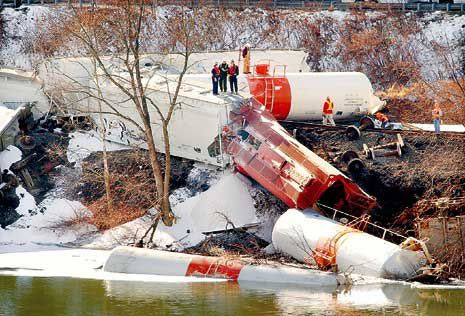
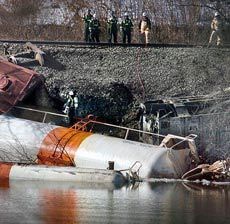
It will be at least Wednesday before about 200 East Deer residents evacuated
because of a train derailment and chemical spill are allowed to return
home. Monday morning's derailment left a tanker carrying anhydrous hydrogen
fluoride upside down in the Allegheny River near the New Kensington bridge.
The gaseous chemical, when mixed with water, turns into a corrosive acid
called hydrofluoric acid, said an emergency response coordinator with
the state Department of Environmental Protection.
Although the emergency response coordinator described hydrofluoric acid
as "one of the nastiest acids around," he said there wasn't
a significant effect on the river water. "It appears to be a slow
enough leak, and there are billions of gallons of water to dilute it,"
the co-ordinator said. "So far, there's not a problem for drinking
water. They're monitoring it." Thirteen cars of an 84-car Norfolk
Southern train derailed about 5:30 a.m. on tracks between Freeport Road
and the Allegheny River in East Deer. No injuries were reported. Another
tanker is also in the water but it is not leaking. Officials did not say
what it is carrying.
Chief Allegheny County Emergency Management coordinator, said it could
be at least Wednesday before crews can empty the leaking tanker and remove
it from the water. Two other derailed cars also contained anhydrous hydrogen
fluoride, but neither was leaking, officials said. The chief Allegheny
County Emergency Management coordinator said workers will begin emptying
those cars today, which could take about 12 hours per car. The evacuation
order affected about 200 residents within a half-mile of the crash site
on the East Deer side of the river. The New Kensington bridge was shut
all day, and all boats were barred from the river between the Tarentum
and New Kensington bridges.
East Deer commissioners Chairman said Oakmont Water Authority stopped
taking water from the river from about 6 to 8 p.m. because of increased
fluoride levels, but service was unaffected. The tanker cars hold 15,000
to 20,000 gallons, but officials could not say how much of the chemical
was being transported. The commissioner said a "good bit" of
the chemical appeared to be leaking into the river, because the tanker
was getting lighter. "The car being in the water is actually working
to our advantage," the commissioner said. "A scrubbing effect
is occurring under the water." The emergency response coordinator
said anhydrous hydrogen fluoride reacts with water, making it too dangerous
for divers to get close enough to pinpoint the leak. Crews determined
the leak is near a dome on top of the tanker, which is underwater. The
water is rippling and bubbling near that spot, and a small white vapor
cloud is above it, the emergency response coordinator said.
One concern is keeping the gas from leaking into the air once the tanker
is lifted out of the water. Inhaling the gas would cause instantaneous
burning of the eyes and lungs, the emergency response coordinator said.
He said hydrofluoric acid is so corrosive, "it will eat through glass."
When it's transported in its acidic form, containers must be lined in
wax, the emergency response coordinator said.
Officials are still investigating what caused the wreck Chief Allegheny
County Emergency Management coordinator said that while no cause has been
ruled out, sabotage seemed unlikely. Determining the cause could take
weeks, said Norfolk Southern spokesman . He said interviews with conductors
ruled out operator error, and the three members of the train crew were
given a routine drug and alcohol test. "It's really a processof elimination,"
the spokesperson said. "We need to look at the equipment and track
and start ruling things out," He said the first priority is safety
and getting the tracks back together. The train was traveling from Conway
to Allentown, where the cars were to be put on other trains for delivery,
the spokesperson said. It carried products including lumber, flour, plastic
pelletsand corn syrup.
View full story here
USA, COLO, FEBRUARY 2 2005. GAS PUMP EXPLOSION COSTS COLORADO C-STORE
The owners of a Frisco convenience store where a gas pump exploded last
year must pay nearly $100,000 dollars for serious and willful violations
of the Occupational Safety and Health Act, according to the Associated
Press.
A maintenance clerk at the Loaf N' Jug was trying to fix a slow gas pump
when a fuel leak occurred. The gas ignited and the pump exploded, injuring
seven people.
The OSHA violations were for improper training and a lack of safety equipment,
including the metal hammer used to break the glass that covered an emergency
shut-off switch and protective equipment for workers' eyes, face and hands.
The company has 15 working days to fix the problems and pay $92,500 in
fines, or contest the findings.
LEAK SUSPECTED IN FIERY PIPELINE BLAST - GASOLINE EXPLOSION
SPURS EVACUATION OF DOZENS; PASSING CAR MIGHT HAVE SET IT OFF
The gasoline explosion and fire at a pipeline in South Whitehall Township
at dawn Tuesday chased dozens of residents from their homes, some in little
more than their nightclothes, and sent a towering pall of sun-dimming
smoke drifting over the Lehigh Valley.
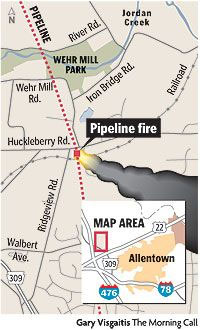
Gasoline from the pipeline at Huckleberry and Wehr Mill roads continued
burning early today, and the evacuated residents were offered overnight
shelter at two hotels. Authorities said they would have to wait for the
fire to burn out before conducting a full investigation, but speculated
that a leak in the pipeline might have been ignited by a passing car.
Similar events along the nation's massive pipeline network in recent
years, some of them deadly, have been blamed on equipment failures, corrosion
and related causes. No one was injured in the 6:30 blast, not even two
motorists whose vehicles were engulfed by flames as they drove past. Heat
from the fire melted the siding on the nearest home.
The FBI and the Bureau of Alcohol, Tobacco, Firearms and Explosives were
at the scene, but authorities downplayed the possibility of terrorism.
''There's no reason to think it's anything other than an accident,'' said
operations manager for Mobil Pipe Line Co., the line owner. The company
is a subsidiary of petroleum giant ExxonMobil. The line is one of three
major pipelines that cross the Lehigh Valley.
The explosion happened at an above-ground junction station where gasoline
is diverted from the 8-inch main pipeline into a 6-inch spur line that
leads to Allentown. The operations manager said it is possible one of
the cars passing the fenced station at the time of the explosion somehow
ignited leaking gasoline. That theory was bolstered by the account of
a local resident schoolteacher, who lives in the 4000 block of Old Sentry
Road in South Whitehall. She said she saw liquid shooting out of the junction
as she drove by at 6:25 a.m., minutes before the explosion, and didn't
have a chance to call the emergency number posted at the site.
The fire raged as officials allowed gasoline remaining in the line to
burn off. Officials said the closest shutoff valves on the north-south
line were 10 miles away in each direction, accounting for the long burn-off
period. Firefighters built a sand dam to contain whatever gasoline hadn't
burned, and vacuum trucks were brought in to suck up the liquid. ''There
has been some fuel spilled on the ground but no one seems to know what
quantity,'' said Township Manager worrying about possible tainting of
the area's residential and municipal wells. The state Department of EnvironmentalProtection
tested the air and water in the area and discerned no immediate health
threats. An emergency response manager with the agency, said the groundwater
would have to be monitored for some time to make sure wells are not tainted.
''The long-term impact is a concern,'' he said. Authorities evacuated
43 homes and advised people across a larger area to stay indoors if they
are prone to breathing problems.
The residents were to be kept out of their homes overnight, though they
were allowed back briefly to gather belongings. They were escorted by
firefighters who brought instruments to test for volatile vapors. Airspace
over the scene was restricted for a while, but that did not affect operations
at Lehigh Valley International Airport, said LVIA's top official.
A shelter was established at Parkland School District's Troxell Administration
Building. ''I didn't even get my coat,'' said another resident, recounting
how she and her husband, fled in their car on Huckleberry Road as gasoline
burned in the gutters on either side of the street. Yet another resident,
a diabetic, left the house in a T-shirt and slippers and forgot his insulin.
''For a few minutes, it looked like we were in big trouble,'' said another
resident, whose Brickyard Road home sits just yards from the station and
was closest to the explosion. Firefighters doused the house to stop the
siding from melting. ''It looked like the whole neighborhood could have
been gone,'' he said. The wife of the resident who lives closest to the
explosion said she heard three loud booms around 10 seconds apart.
The 480-mile pipeline carries gasoline, diesel fuel and heating oil from
Paulsboro, N.J., near Camden, to Buffalo, N.Y., said Mobil Pipe Line spokesman.
The spur to Allentown is 7 miles long. Officials said the portion of the
pipeline in South Whitehall was last inspected in November by the Office
of Pipeline Safety, a division of the U.S. Department of Transportation.
The pipeline spokesman said the inspection revealed no ''findings,'' or
major problems.
An ExxonMobil spokeswoman said the pipeline dates to 1950. It courses
through the Lehigh Valley, roughly paralleling the Turnpike. At the time
of the blast, the line was carrying gasoline under pressure of 1,400 pounds
per square inch. ''The flames were at least 75 feet in the air,'' said
a resident who lives on Loring Drive off Huckleberry Road. ''The smoke
… it was a like a big mushroom cloud.'' South Whitehall Commissioner,
who lives on Brickyard Road, estimated the height of the explosion at
175 feet, based on scorch marks in the trees.
Several other residents who live close to the site didn't hear the explosion.
A local couple, who live in the 3700 block of Huckleberry, didn't know
anything was amiss until their son called to ask if they needed a place
to stay. Another residetn who lives in the 3800 block of Huckleberry,
said he heard a muffled thud. ''You kind of knew it was an explosion,''
he said. Another resident of Brickyard Road was walking a dog he calls
''The Schnutz'' when he saw the explosion and watched flames race along
the ground. A resident who has lived at Huckleberry and Brickyard roads
for 56 years, said the blast shook her out of a sound sleep. ''It sounded
like Trojan going up again,'' she said, referring to a gunpowder plant
that operated in the area until the 1970s and was the scene of several
major explosions. Another Huckleberry Road resident said he heard a small
explosion followed by a larger one. ''I looked out my picture window and
there was a ball of fire,'' he said. The flames ''were as high as the
tops of the trees.… I thought initially it was an oil truck or gasoline
truck exploding.'' Another resident a self employed physical therapist,
was overlooked in the evacuation. Noticing how quiet the neighborhood
had grown in the hours after the explosion, she went for a walk and encountered
a surprised firefighter who said, ''Where have you been? We thought we
got everybody out!''
The Pennsylvania Emergency Management dispatched two people from its
eastern regional office in Hamburg, the PEMA Director said Although PEMA
is technically the lead state agency in any disaster, the Director said
county officials had the situation Tuesday well in hand and that PEMA
was primarily offering counsel and technical support.
The explosion played havoc with the morning rush hour. Parkland Superintendent
said homeroom period at Parkland High School was extended to allow for
late-arriving students. ''Traffic was a little crazy,'' she said. ''Everyone
was tied up this morning.'' At a 6 p.m. news conference at the South Whitehall
Municipal Building, officials could not yet estimate the amount of gasoline
lost in the incident. The Parkland Superintendent said a fairly accurate
tally eventually will be made.
The DEP spokesman said that while no immediate groundwater contamination
is known, bottled water will be provided ''as a precaution'' for residents
of evacuated homes served by private wells. The public water supply is
safe, he said.
Officials had yet to determine what ignited the gasoline. The operations
manager for Mobil Pipe Line Co declined to speculate about what other
causes might be possible, other than one of the passing cars. ExxonMobil
is paying the hotel and food bills and related expenses for the evacuees,
and the Red Crossprovided meals and drinks.
NO SERIOUS INJURIES IN FORKLIFT TANK BLAST
A forklift leaking propane exploded early Tuesday at a freight warehouse,
injuring an employee and causing firefighters to duck for cover as fragments
of burning metal flew past them. The explosion and fire was reported about
1:15 a.m. at Velocity Express, 1217 Minters Chapel Road. An employee,
who fire officials did not identify, suffered burns as he attempted to
stop the leaking propane, a fire official said. The employee was taken
to Baylor Regional Medical Center at Grapevine, but his condition was
unavailable. His injuries were not believed to be life-threatening, fire
officials said.
Employees told firefighters that they were attempting to replace a propane
tank on the forklift when it began to leak. About five employees were
in the area, according to fire reports. "The liquid propane vapors
became too much for the employees, so they ran out of the area,"
said Grapevine Fire Marshal. "Within 30 seconds after they left,
the forklift exploded. The vapors probably contacted the heat of the forklift
and that caused the explosion." The explosion ignited a fire on the
forklift and a nearby trailer loaded with office supplies, causing about
$15,000 damage, the Fire Marshal said. The warehouse was not damaged,
he said. The Fire Marshal said firefighters were lucky they were not injured
by the fragments. "The employees got out just in time, and if firefighters
had gotten there a few seconds earlier, they would have been hit."
AIRPORTS COMMISSION AND FUEL COMPANIES FINED FOR EXTENSIVE FUEL LEAKS
AT AIRPORT
The Metropolitan Airports Commission and two fuel companies at Minneapolis-St.
Paul International Airport have been fined $125,000 and must spend more
than $3 million on various airport improvements for a series of fuel leaks
that occurred at the airport two years ago.
The penalties are contained in an agreement reached between lawyers at
the Minnesota Pollution Control Agency, the Metropolitan Airports Commission,
Aircraft Services International and the Minneapolis Fuel Committee.
The agreement, which will be considered by a MAC committee next week,
is the product of a two-year investigation into why thousands of gallons
of jet fuel leaked at the airport. The leaks, which were discovered in
February 2003, contaminated soil beneath the airport and allegedly drained
through storm sewers into the Minnesota River.
GAS PUMP EXPLOSION COSTS COLORADO C-STORE
The owners of a Frisco convenience store where a gas pump exploded last
year must pay nearly $100,000 dollars for serious and willful violations
of the Occupational Safety and Health Act, according to the Associated
Press. A maintenance clerk at the Loaf N' Jug was trying to fix a slow
gas pump when a fuel leak occurred. The gas ignited and the pump exploded,
injuring seven people.
The OSHA violations were for improper training and a lack of safety equipment,
including the metal hammer used to break the glass that covered an emergency
shut-off switch and protective equipment for workers' eyes, face and hands.
The company has 15 working days to fix the problems and pay $92,500 in
fines, or contest the findings.
OSHA LEVIES FINE IN GAS STATION EXPLOSION
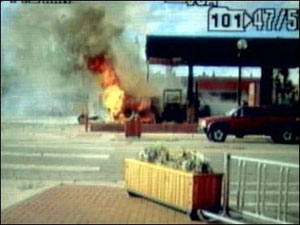
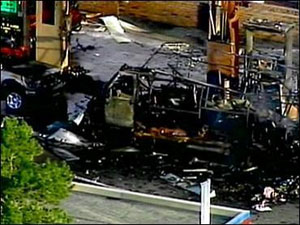
Seven people were injured on Aug. 4 in Frisco when an explosion and fire
at a gas station pump destroyed an RV.
The owners of the Frisco store where a gas pump explosion injured seven
people last year have been fined more than $92,000 by federal workplace
safety officials. The company was cited last week and has15 days to fix
the problems and pay $92,500 or contest the findings, said Denver area
director of the Occupational Safety and Health Administration.
A maintenance clerk at the Loaf N' Jug was trying to fix a gas pump
Aug. 4 when leaking fuel caught fire and the pump exploded. The agency
accused the owners of improper training and a lack of safety equipment,
including the hammer used to break the glass covering an emergency shut-off
switch for the pump. It also said employees had no way of verifying the
pumps were off.
CYANIDE SPILL AT OLD MINE
Cyanide has erupted from a storage tank at an abandoned Northern Territory
mine while contractors hired by the NT Government were trying to neutralise
the chemicals. More than 500 litres of cyanide escaped from a storage
tank at the Mount Todd gold mine near Katherine on the Edith River, southeast
of Darwin, on Tuesday.
Mintech Chemical Industries was hired by the Government at a cost of
$25,528 to remove 700,000 litres of cyanide solution from storage tanks
at the mine after on-site salvagers Aussiequip refused to take responsibility
for it. Territory Mines Department chief executive said that during the
initial neutralisation process in which hydrogen peroxide was introduced
into the cyanide, a vigorous chemical reaction occurred. "The reaction
was due to gases being contained by crusted iron compounds within the
tank as it had been sitting for many years," the chief executive
said. "A quantity of liquid blew out through the vents on the top
of the storage tank. "The reaction caused a rupture between the side
and the roof of the storage tank allowing around 500 litres of liquid
to release."
The chief executive said no one was injured during the eruption. He said
there was also no damage to the surrounding ground or nearby river because
the chemicals were contained by a concrete bund around the site. The chief
executive said the cyanide solution was the last thing left that could
be dangerous on the mine site. "There is a lot of acid rock there
which is something we have to manage as when the water gets into it a
lot of nasties can leach out," he said. "But in terms of dangerous
items this (the cyanide) is the last thing we had to deal with. "But
the longer-term major problems which are the longer-term threats to the
environment are ones that still have to be dealt with."
FINGERPRINT CHECKS NOW REQUIRED OF MANY TRUCKERS - HAZARDOUS-WASTE DRIVERS
AFFECTED BY ANTI-TERRORISM LAW
Every truck driver who wants to haul hazardous materials must be fingerprinted
and undergo thorough background checks under a new federal anti-terrorism
law that started this week. Proponents of the new regulations say they
may help stop criminals or terrorists from getting behind the wheel with
cargo that could be used to explode buildings or unleash biological or
chemical threats.
The problem is some local truckers think it's a waste of time. The new,
tougher restrictions went into effect Monday. They call for the FBI to
use the fingerprints to check each driver's criminal background and immigration
status.
A truck driver who has been hauling big rigs for 26 years, questions
whether the new federal law is foolproof. He transports 8,500 gallons
of gasoline at a time in a big silver tank for Usher Transport Inc. to
places such as Sam's Wholesale Clubs. ''What is fingerprinting going to
do?'' asked the truck driver, as he connected the hose from his rig to
an underground storage tank at the Sam's Club on Harding Place. ''Fingerprinting
won't do nothing. It won't protect this country.'' The check will search
for any violent crimes or terrorist ties, as well as any past mental problems.
Additional rules will take effect May 31, requiring the same fingerprint-based
checks for veteran drivers who are either renewing or transferring the
hazardous materials endorsements on their state-issued commercial driver's
licenses. That affects the 107,047 commercial driver's license holders
with ''hazmat'' endorsements in Tennessee, according to a spokeswoman
for the Tennessee Department of Safety. There are 2.7 million hazmat drivers
nationwide. They drive substances that are flammable, corrosive, poisonous
or that otherwise pose a danger to the public if they're mishandled, including
petroleum products, acids used in industry, explosives, bug- and weed-killing
chemicals used on farms, and solvents.
''We feel that this is an important measure to put in place to ensure
that we were able to create safeguards for transportation of dangerous
commercial products,'' according to a spokeswoman for the Transportation
Security Administration. The head of the Tennessee Trucking Association,
which represents more than 500 trucking companies and industry vendors,
called for support for the new requirements. ''We think it's certainly
a worthwhile effort,'' said the association president. ''It's an extra
layer of security for the transportation of hazardous materials, and we
are doing our part.'' The process will takeabout two weeks to complete,
the TSA estimates. In the past, a private company conducted the background
checks. Now, those reviews will be conducted by the TSA with the FBI's
help. If there are any red flags, the truckers won't get their hazardous
materials endorsement licenses. The law allows them to appeal. Drivers
who have their licenses must renew at least every five years. Some trucking
organizations are opposed to the new rule, calling the new process unnecessary
and ineffective. They also cited ''unfair costs'' to drivers. ''We support
the program, but we believe it was implemented too prematurely,'' president
of the National Tank Truck Carriers Association, based in Alexandria,
Va. ''Within the various states, we just do not believe that there are
enough facilities that have been established to accomplish the fingerprinting.''
President of the National Tank Truck Carriers Association argued that
the new initiative is not ''user-friendly to drivers.'' ''These drivers
will have to travel some extensive distances at least twice: Once to get
fingerprinted and once — presuming they passed the test —
to go back and get their licenses,'' said president of the National Tank
Truck Carriers Association, whose members of the association employ about
55,000 drivers. ''For truck drivers who are constantly on the road, this
means they are going to have to do it either on their private time or
take time off and lose pay.'' The fees vary from state to state and range
from $25 to $99 per driver, trucking companies said.
There are some concerns among drivers whether the fee should be paid
either by them or by the company for which they haul. Some say any initial
hardships — either financial or timewise — for the trucker
is worth it for the country's safety. ''It's not a matter for discussion,''
said terminal manager of Highway Transport Inc. in Nashville that hauls
gas. ''We just roll with it. Most people have the attitude that the reason
behind the program is good enough for why it has to be done. With the
type of hazardous materials we handle, we wouldn't want it to fall into
the wrong hands.''
The new federal requirements were supposed to take effect in 2003, but
they were delayed a few times after states complained about the deadline
for setting up the fingerprinting system, said president of the National
Tank Truck Carriers Association said. ''Our stakeholders indicated they
were going to have trouble meeting that deadline, so we worked with them
to establish an appropriate timeline, and that deadline was'' Monday,
she said.
Nashville-based Integrated Biometrics Technology landed a contract with
the TSA to implement and operate the fingerprinting system. The system
will get rid of the old ink prints that would take weeks for the FBI to
process. It will electronically scan the driver's prints, forward them
to the FBI's fingerprint-processing center and provide results to the
TSA in about a day. Thirty-four states have signed up to use IBT. However,
Tennessee is among the states that will take care of the fingerprinting
on its own.
View full story here
OIL SPILL CLEAN-UP REACHES LOUISVILLE
The effort to clean up the big oil spill from the Kentucky River has
reached Louisville. Clean up crews hired by the oil pipeline company are
now here. Louisville's 4th Street Wharf is about 55 miles away from the
site of the oil spill, but Friday, an oil absorbent boom is now in the
Ohio River near The Belle of Louisville.
A steady flow of oil has been seen in the Louisville area for the past
few days as it started seeping out of the Kentucky River and into the
Ohio. National Recovery Corporation has set up field crews to collect
the oil at Cox Park and other areas.
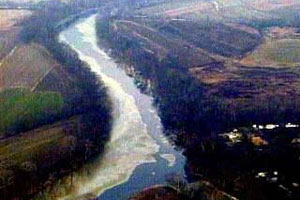 |



